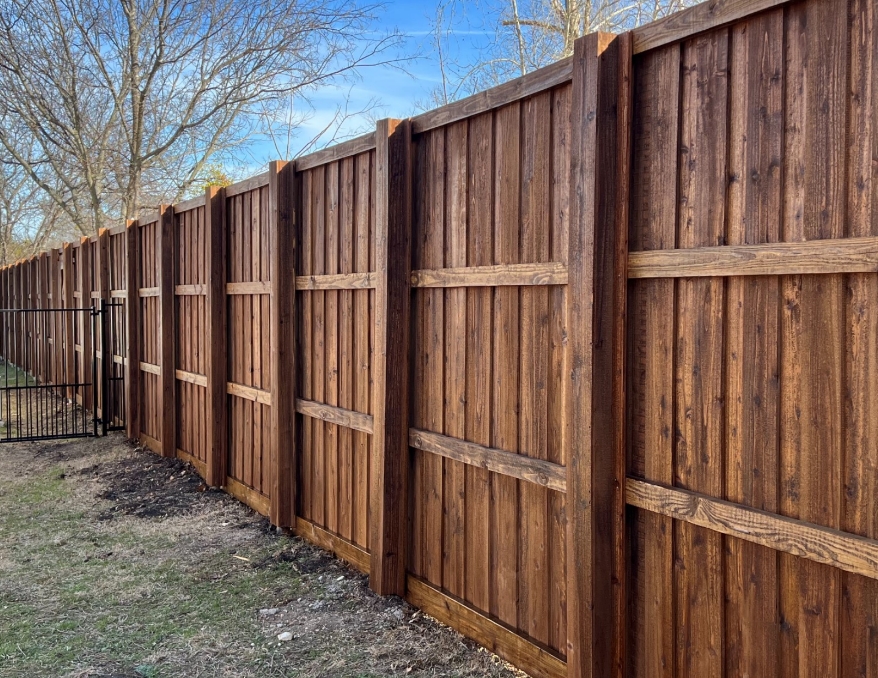In most DFW neighborhoods like Mansfield, Arlington, Waxahachie, or Cedar Hill, it’s common for your backyard fence to sit right on the property line—meaning you and your neighbor both get a front-row view. Whether you’re planning to replace an old fence, repair a few leaning posts, or build something brand new, a little neighborly communication goes a long way toward keeping the peace and making sure everyone’s happy with the final result.
Here’s a simple guide to fence etiquette and best practices that can help you handle your project the right way.
Talk Before You Build
Even if you’re not required to get your neighbor’s permission, it’s always smart—and polite—to give them a heads-up before making big changes to a shared fence.
Start with a friendly chat about your plans:
- Are you repairing a section, replacing the whole fence, or just updating the look?
- Do they want to be involved in the process—or maybe even split the cost?
While Texas law doesn’t require neighbors to pitch in for a new fence, many homeowners are willing to share costs when it benefits both sides. A quick conversation can save you from surprises later—and maybe even get you a partner in the project.
Double-Check Those Property Lines
Before you set a single post, make sure you know exactly where your property ends.
If your fence accidentally crosses onto your neighbor’s land, they’re legally allowed to have it taken down—and no one wants to deal with that. To be safe, check your property survey (usually included in your home purchase documents). If you can’t find it, your county records office or a licensed surveyor can help confirm the boundary.
It’s a small step that can prevent a big headache.
The “Good Side Out” Rule
Here’s a golden rule of fence etiquette: the nice side faces out.
If you’re installing a wood privacy fence, the smooth, finished side should face your neighbor or the street, while the side with rails and posts faces your yard. It’s not just polite—it’s standard practice across Texas and, in some cities, even required by code. Plus, your home will look better from the outside, too.
If you’d rather not worry about which side is which, consider a “good neighbor fence.” These are built to look the same on both sides—like shadowbox or horizontal board styles—so everyone gets a clean, polished view.
Be Mindful During Construction
When it’s time to build or repair, remember that your neighbors’ space matters, too.
- Avoid damaging their landscaping or sprinklers.
- Let them know ahead of time when construction will happen, especially if there’ll be noise, workers, or temporary gaps in the fence.
- If they have pets, give them notice before removing an old fence section so they can plan accordingly.
A little communication here can prevent a lot of awkwardness later.
Maintenance Matters
A shared fence means shared visibility. Even if the fence is technically on your property, keeping it in good shape shows respect for your neighbor—and helps maintain everyone’s curb appeal.
Regular upkeep like cleaning, staining, sealing (for wood fences), or fixing loose boards keeps things looking sharp. If maintenance sounds like too much work, materials like vinyl or aluminum are great low-maintenance alternatives that still look great year-round.
Who Pays and Who Owns It?
This one can get tricky. If the fence sits directly on the property line, both neighbors might have a claim to it—but typically, whoever builds or repairs it pays for it.
That said, many neighbors will happily share costs if you talk it through first. Just don’t assume—it’s better to ask early and avoid misunderstandings later.
If you’re not sure who owns an existing fence or whos responsibilty it falls to, check your property documents or talk it out with your neighbor before making changes.
Keep It Neighbor-Friendly
When planning your design, think about how the fence will look from both yards. A cohesive, neighborhood-friendly design keeps everyone happy and helps boost overall property values.
M&C Fence DFW often recommends modern horizontal or shadowbox-style fences for shared yards—they look great on both sides and offer privacy without feeling closed off.
Communication Is Key
At the end of the day, good fences really do make good neighbors—but only when paired with good communication. A quick chat, a thoughtful design, and some courtesy during installation go a long way toward keeping your home (and your relationships) in great shape.
At M&C Fence DFW, we build more than fences—we build trust. If you’re planning a new fence or repair project, starting with a free quote, we’ll handle it with professionalism, respect, and care for your property and your neighbors’.


